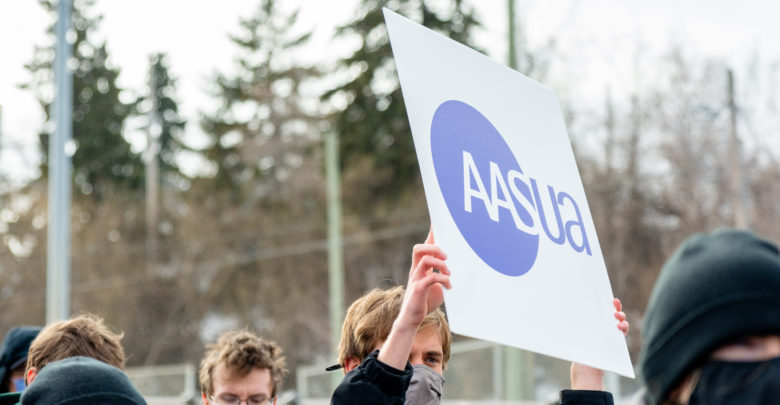 Lochlann Kerr
Lochlann KerrIt’s hard to teach the next generation of thinkers when you’re too busy fighting to keep the lights on in your office. Yet that’s the situation University of Alberta academic staff find themselves in. While a tentative agreement has been reached, the Association of Academic Staff at the U of A (AASUA) has had to make several concessions. And members could still vote against the agreement. If they do, we will be right back to where we were: a possible strike or lockout hanging over all of our heads. It’s not just about getting better salaries and benefits for academic staff. It’s about proving that quality education can’t survive on gratitude alone.
For more than a year, AASUA has battled the university in bitter negotiations over wages, benefits, and job security. The union represents roughly 4,000 instructors, librarians, researchers, and academic professionals. On September 19, they declared an impasse in formal mediation after negotiations failed to produce meaningful progress. That decision triggered a legally required two-week cooling-off period, after which AASUA applied for a supervised strike vote set for October 6–9. In response, the university began the process for a potential lockout vote of its own.
A tentative agreement has been reached as of October 1, which means there won’t be a strike vote or a lockout. Yet. Just like with the Alberta Teachers’ Association, members could vote down the agreement, and another impasse could ensue.
The university insists it’s been bargaining in good faith. But AASUA has argued that after years of stagnant wages, rising workloads, and shrinking resources, members are simply demanding fairness. When budgets tighten, staff — and by extension, students — are often the first to pay the price.
Compensation has been a sticking point. AASUA’s push for competitive salaries isn’t about greed. It’s about retaining and attracting the talent that keeps the U of A a top-tier institution. Academic staff salaries at the university lag behind those at peer institutions. This is making it harder to recruit the researchers and instructors students deserve. It signals to early-career scholars that their contributions aren’t valued and that better opportunities likely exist elsewhere.
The consequences extend far beyond faculty lounges and lecture halls. When short-term contracts dominate teaching positions, instructors have little time or security to develop courses, mentor students, or plan long-term research. When office space is cut or shared, students lose access to the informal conversations that spark new ideas and deeper understanding. And when benefits erode, staff face added stress and instability, all of which trickles down into the quality of teaching and support students receive.
Crucially, AASUA did not jump straight to strike action. The union attempted informal mediation earlier this year, followed by formal mediation in September. It even filed an unfair labour practice complaint in May, alleging that the university wasn’t bargaining in good faith and that provincial mandates were tying its hands. The university denies the accusations, but the complaint reflects just how broken the process has become.
Agreeing to a tentative agreement is itself proof that AASUA is bargaining in good faith and genuinely trying to resolve this dispute. After 18 months of drawn-out negotiations, the union’s willingness to consider compromise shows a commitment to reaching a solution without dragging students and staff through a full-scale strike. Yet even now, the university has conceded very little on key issues like job security, benefits, and compensation. That imbalance highlights the broader problem at the heart of this standoff. While AASUA continues to negotiate in earnest, the administration remains reluctant to make meaningful changes that would address the root concerns.
Many overlook the role government policy plays in shaping this entire situation. Alberta’s Ministry of Advanced Education sets strict compensation frameworks that universities must follow. These political limits, imposed in the name of “fiscal discipline,” constrain bargaining power and force institutions to prioritize cost savings over educational quality. When public funding declines — as it has repeatedly over the past decade — administrators become reluctant to offer meaningful raises or improve job security. The result is a pressure cooker where academic workers are asked to do more with less while the province congratulates itself on balanced budgets. The province touts itself as an emerging research hub. Undermining the very people who conduct that research is short-sighted.
Some argue a strike would only hurt students — delaying grades, disrupting labs, and jeopardizing degrees. That’s a valid concern, and students would have every right to feel frustrated about cancelled classes. But it’s worth asking why things reached this point in the first place. If the university had prioritized fair negotiations, the semester wouldn’t be hanging in the balance. Strikes are not acts of selfishness; they are acts of last resort. When staff feel they have no other way to defend their livelihoods and the quality of education, walking out becomes the only tool left.
Others contend that a university, like any employer, must balance its budget and can’t meet every demand. That’s also true — but it misses the bigger picture. A university isn’t a business selling widgets. Its core “product” is knowledge, and that product depends entirely on the people delivering it. Cutting corners on staff pay, benefits, and job security is like cutting corners on lab equipment or library resources. It might save money in the short term, but it undermines the institution’s mission in the long run. And when that mission falters, students pay the price in diminished opportunities, outdated curricula, and a diminished global reputation.
Even with a tentative agreement reached, this dispute puts a significant amount of institutional credibility on the line. A fact that many overlook. A research university thrives on its reputation for attracting top scholars, publishing groundbreaking work, and competing internationally. When staff are pushed into a cycle of insecure contracts and inadequate compensation, it damages the university’s standing and makes it harder to recruit or retain the talent that drives innovation. By defending their contracts, AASUA isn’t only safeguarding members — they’re defending the university’s reputation as a serious academic institution.
Strikes are messy, inconvenient, and disruptive, and we may very well still end up having one. But they’re also one of the few ways workers can push back when dialogue fails. AASUA isn’t fighting for perks or special treatment. They’re fighting for the conditions that make the U of A a place worth studying and working. A strike may cause short-term headaches. However, the alternative — a slow erosion of quality, morale, and talent — would be far worse. If the administration truly cares about students and the university’s future, it will stop treating staff as expenses to be contained and start treating them as partners in the educational mission.
Regardless of where the tentative agreement goes, AASUA deserves students’ support. They’re not just standing up for themselves; they’re standing up for the future of the classroom.




